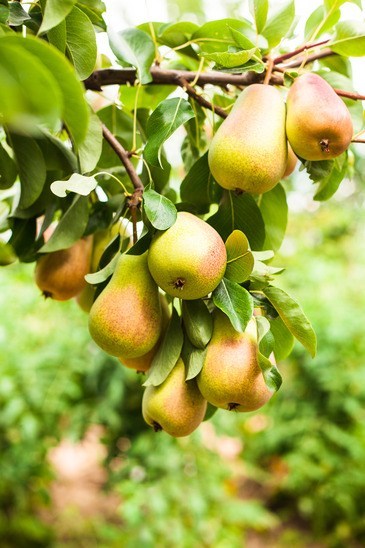
Just because you live in Florida, doesn't mean the pears you grow have to look and feel like baseballs!
It just means you need a low chill pear tree variety that produces soft pears.
While the hard pear trees can be quite hardy and the pears make good preserves -- if you add enough sugar -- there are suitable alternatives for snacking pears.
If you like to eat your pears fresh, then buy a pear tree from one of these three soft varieties:
The three tastiest and most suited pear trees to grow in North Central Florida or even Central Florida are the
- HOOD pear
- FlordaHome pear
- and the little known Spalding pear.
Here's a look at each one:
HOOD Pears
HOOD pears are a popular variety of soft pears, suitable for eating raw but also good for cooking. The texture is what you would expect from a good eating pear: neither grainy or bitter. Hood is a golden yellow pear with a soft buttery flesh. The flavor is a bit tangy, something like a Bartlett. (Bartlett is the number one pear for commercial production in the US.)
At 150 chill hours, the HOOD pear tree is a low chill variety suited to zones 8-10. Fruit ripens in mid July to early August. It requires a pollinator from either the FlordaHome, Spalding, or Pineapple pear.
FlordaHome Pears
FlordaHome is a tasty, sweet soft pear, somewhat greenish skin and great for fresh eating or making preserves as well. It is another low chill variety, and just like the Hood, requires only 150 chill hours to produce fruit, though many growers simply say "requires less than 400 hrs." The fruit ripens in late July.
The FlordaHome is a hybrid developed by IFAS specifically for North & Central Florida backyard gardens. It is not quite as disease resistant as the HOOD in the colder areas, but makes a tasty good pollinator that can be eaten fresh. The FlordaHome is actually a more reliable pollinator for the favored HOOD than the (hard) Pineapple pear. It needs a pollinator to produce from either the HOOD, Spalding, or Pineapple pear.
Spalding Pear Tree
Spalding pears are soft & delicious for eating raw, but hold their shape well for cooking too. The fruit is soft but crunchy, amazingly sweet, juicy and full of interesting flavor. It is not widely distributed here and difficult to find except at smaller nurseries.
Spalding Pears are another soft pear requiring only about 150 chill hours and blooms at the same time as the HOOD, FlordaHome, or (hard) Pineapple pears. So any pears from this group can pollinate each other. It is worthy of mentioning, the Spalding pear tree is one of the few that is a prolific, self fertile variety -- it actually doesn't need a pollinator.
Spalding is highly disease resistant, especially to fireblight bacteria. Though it blooms at the same time as the HOOD & the FlordaHome, the fruit ripens later, in September, effectively extending your fruiting season another month.
So, if you've got a taste for soft pears and live anywhere in Florida in zones 8-10, you can plant these 3 pears together for the biggest, sweetest crop:
HOOD, FlordaHome, and Spalding.
That way you'll have fresh pears ripening from mid July all the way into late September!
And don't forget, you can also freeze pears (without them turning brown!) for use in fruit salads throughout the rest of the year. But that's another article 😀
BUY SOFT PEARS
Delivery in Alachua County only
